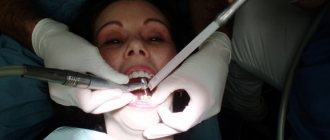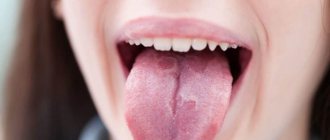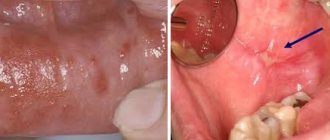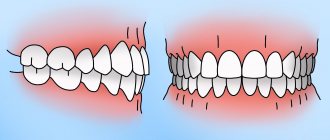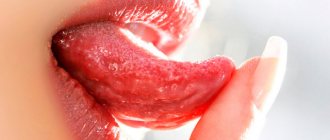The human tongue is closely connected with the visceral organs and is capable of responding to pathological changes in internal systems. Diseases of the visceral organs are manifested by structural changes in the mucous membrane of the tongue or the appearance of various plaques, the color of which can explain the source and nature of the problem.
Principles of diagnosis by language
Determining diseases by the condition of the tongue is an undervalued technique in European diagnostics, but is widely used in Asian countries, especially in traditional Chinese medicine. According to clinical observations, there is a close connection between damage to internal organs and different parts of the mucous membrane.
When carrying out diagnostics, the color, density and smell of plaque are taken into account.
To accurately determine the affected organs, it is necessary to understand which parts of the mucous membrane react to which organs. In accordance with the classic map of interconnected departments, the following matches are distinguished:
- the tip and anterior edge of the tongue react to changes in the functioning of the cardiovascular and respiratory systems;
- a longitudinal groove indicates problems in the gastrointestinal tract;
- the lateral surfaces are connected with the organs of the hepatobiliary and urinary systems;
- the basal transverse line coincides with the spine and other parts of the musculoskeletal system.
- the location of the projections of the internal organs on the tongue coincides with the schematic placement of the internal organs.
Do not forget that the appearance of plaque and ulceration of the mucous membrane in any part of the tongue indicates the presence of pathological processes in interconnected organs.
Dry mouth means that normal saliva production is disrupted. Insufficient secretion of the salivary glands may be a sign of the development of a pathological process in the body. Read more in the article: “why your mouth gets dry: causes and treatment.”
Causes of glossitis
As mentioned above, glossitis can act as an independent disease, or it can be the result of a pathology of the body. Bacteria (streptococci and staphylococci), herpes viruses and fungal flora can provoke the inflammatory process.
If the disease is non-infectious in nature, then a tongue injury can serve as the impetus for its development. It can be injured by fragments of teeth, sharp edges of dentures or fillings. The tongue is a delicate organ; chemical irritants, as well as exposure to high temperatures, can damage the integrity of its membranes. The likelihood of developing glossitis increases in people who abuse alcohol and smoke a lot.
Other risk factors for developing glossitis include:
- Consumption of hot foods and drinks, spices and caramel
- Poor oral hygiene
- Using mouth fresheners or toothpaste too often and in excess
- Using someone else's toothbrushes
- Wearing braces and dentures
- Piercing the tongue to place earrings in it
Glossitis can be a consequence of pathologies such as:
- Vitamin deficiency (E, A, B12, folic acid)
- Diseases of the dermis
- Dry mouth
- Anemia
- Measles and scarlet fever
- Diphtheria
- Diseases of the digestive system
- Infection with worms
- Lichen planus
- Allergy
- Stomatitis
- Rheumatism
- Uncontrolled use of antibacterial drugs.
The chronic form of the disease can be triggered by dysbiosis or a general decline in the body's immune forces. At the same time, it produces autoantibodies that increase inflammation.
Statistics indicate that glossitis most often develops in men over the age of 40. However, when the tongue is exposed to traumatic factors (burn, trauma, chemical damage), the disease manifests itself at any age.
Glossitis rarely develops only under the influence of a single factor. Most often, they appear in combination, when a person has diseases of the oral cavity and disturbances in the functioning of the gastrointestinal tract, then an injury or burn can trigger the onset of inflammation. If the tongue is constantly influenced by chemical factors, then the likelihood of developing glossitis increases.
Features of the raid
Diagnostic measures aimed at identifying diseases by the color of the tongue should take into account the characteristics of plaque. There are two types of mucosal lesions:
- Physiological plaque
. This phenomenon is observed when the papillae are stained with food dyes (black tea, coffee, fruit and vegetable juices, confectionery). Physiological coloring quickly disappears when you avoid products containing coloring pigments. - Pathological plaque
. Appears as a result of functional disorders of visceral organs or infectious diseases of systemic organs and structural tissues of the nasopharynx.
When diagnosing, the physiological and pathological characteristics of plaque are differentiated by examining the quality of the latter. If a change in the surface of the mucous membrane is caused by coloring pigments, then such a manifestation does not pose a danger to the body and is of no value in establishing a diagnosis.
The combined antiseptic Fukortsin is used by patients as a disinfectant for external use to treat abrasions and wounds, fungal rashes or pustules on the skin surface. Read more in the article: “fucorcin solution - indications for use.”
Forms and types of disease
Inflammation of our organ of taste occurs frequently and does not always manifest itself with symptoms, proceeding completely hidden from us.
There are several forms and types of the disease:
- According to the duration, the disease is divided into acute (develops quickly and lasts no more than a month) or chronic glossitis (lasts more than a month);
- According to the form of the lesion, the catarrhal form (proceeding with redness and swelling) and the desquamative form (proceeding with a change in appearance) are distinguished;
- purulent forms - phlegmon and abscess (a purulent focus in the thickness of the organ tissue itself);
- a separate group includes neurological diseases of the nerves innervating this organ.
Cellulitis and abscess occur acutely, they are associated with infection and require urgent surgical intervention. They manifest themselves as severe pain, chills and swelling of the lymph nodes of the neck - this form can be confused with acute inflammation of the salivary glands, so diagnosis using ultrasound and x-rays is needed. It is better not to delay these symptoms and seek medical help as an emergency.
The catarrhal form of glossitis manifests itself with a sharp blood supply - the tongue swells, becomes bright red - this can manifest itself, for example, with scarlet fever, or an allergic reaction, which, in addition to the organ of taste itself, spreads to the soft palate with the tongue. Treatment in this case is aimed at eliminating the allergic reaction and inflammation.
The largest and most heterogeneous group is desquamative glossitis. It is difficult to list the number of factors (external, internal) that can provoke this form of the disease. We will not make a mistake if we say that “the tongue is the mirror of the digestive tract.” Since it contains many nerve receptors and papillae of different shapes and purposes (filamentous, cone-shaped, mushroom-shaped, leaf-shaped, groove-shaped), a change in each link of its anatomy outwardly reveals a hidden disease. Let's take a little look at the most common diagnostic signs of these conditions.
Provoking factors and causes
Various provoking factors cause changes in the color of the mucous membrane and the appearance of layers of plaque on the tongue. These include the following pathogens:
- bacterial microorganisms;
- fungal and viral infections;
- dysbacteriosis of endogenous microflora;
- endogenous and exogenous diseases of visceral organs;
- alcohol abuse, smoking;
- food and toxic poisoning.
In addition to the relationship with pathological changes in internal organs, plaque contributes to the development of secondary infections in the oral cavity and nasopharynx, since it is a breeding ground for anaerobic bacteria.
The reasons why different types of deposits appear lie in the condition of the internal organs and systems. A weakened body is more susceptible to the effects of pathogens and the subsequent appearance of interrelated symptom complexes. There are two main reasons for the formation of plaque in adults:
- tendency to diseases of a bacterial nature;
- damage to individual internal organs.
An additional reason is insufficient oral hygiene. In childhood, the formation of the protein layer is often associated with nutritional principles and hygiene.
What is glossitis?
Glossitis is an inflammatory condition of the tongue that is usually caused by a bacterial or viral infection.
This pathology is characterized by a change in the color of the tongue, its structure, color and overall appearance become different. If ulcerative defects form on the tongue, plaque forms or its natural color changes, these act as signals of a disorder. There are several types of glossitis. They differ in symptoms and causes of the pathological process. Sometimes glossitis does not act as an independent disease, but as a consequence of another pathology present in the body. Glossitis is not a harmless disease, as it affects the neck. It develops in both adults and children. Elderly patients often suffer from glossitis. To cope with inflammation, you need to find out the cause of its occurrence. To do this, you should contact your dentist. The doctor will determine the type of disease. If necessary, he will refer the patient to another specialist. Sometimes patients need the help of an infectious disease specialist, gastroenterologist, immunologist, or allergist.
ICD code
ICD-10:
K14.0
ICD-10-CM:
K14.0
ICD-9-CM:
529.0
Characteristics of pathological plaque
Plaque on the mucous membrane of the tongue, caused by negative provoking factors, is a layer of protein content. The structure of the layer is represented by granular particles that contain exfoliated endothelial scales of the papillae, a small amount of saliva and food debris, and bacterial microorganisms.
Depending on the nature of the underlying pathology, the protein layer can be dense or loose.
There are several colors of deposits - white, yellow, greenish, dark brown or black.
A layer of plaque with pathogenic characteristics covers the tongue, penetrating between the papillae, impeding their functionality and causing irritation of sensitive receptors. Side effects of plaque include the following:
- pain syndrome (occasional or constant pain appears, the tongue stings and irritates);
- decreased sensitivity and numbness, which occurs as a result of prolonged irritation of sensory receptors.
The protein layer can produce a stench due to the activity of anaerobic bacteria. This phenomenon is called halitosis and is a pathognomic sign of the presence of pathologies of internal organs.
White plaque
The most common plaque, which occurs in all age categories, is white. The formation of such a layer is associated with the activity of bacterial microorganisms directly in the oral cavity and nasopharynx. White plaque consists of endothelial particles of the mucous membrane and waste products of bacteria or fungi. Light deposits are characteristic of the following diseases:
- tonsillitis (tonsillitis) and other infectious diseases of the upper respiratory tract;
- thrush (candidiasis).
In bacterial diseases of the nasopharynx, plaque has a uniform structure and is located on the tongue, tonsils and mucous membranes of the throat. A curd coating on the tongue is a characteristic sign of thrush.
Thrush deposits resemble liquid curd mass, and when you try to remove them, they gather into small lumps. Candidiasis in the oral cavity most often develops in breastfed babies and young children. Thrush in an infant develops due to the constant maintenance of a nutrient medium in the oral cavity, since breast milk is the best medium for the growth of fungal cultures of the genus Candida.
Yellow plaque
A light yellow tint to the plaque can occur when drinking coffee and smoking. Intensely colored yellow deposits located on the surface of the mucous membrane of the tongue indicate pathologies of the hepatobiliary tract. The yellow coloration of physiological secretions is caused by obstruction of the bile ducts and high levels of bilirubin. Jaundice pigmentation on the tongue occurs due to the acute course of the following diseases:
| Diseases | Description |
| Liver damage | Destruction of hepatic parenchymal tissue occurs in the presence of various hepatitis, steatosis, leptospirosis, hemolysis, trauma, poisoning with alcohol and toxic substances. |
| Diseases of the gallbladder and ducts (cholecystitis, cholelithiasis) | Inflammation and obstruction of the gallbladder and bile ducts are provoked by dyskinesia, stones and traumatic effects. |
Excessive production of bile pigment, which is involved in the formation of a yellowish plaque, can occur in the presence of chronic pancreatitis. In the inflamed pancreas, a malfunction of enzymatic activity occurs, as a result of which enzymes are released into the bloodstream and damage the structures of the hepatobiliary tract.
Orange plaque
The orange coloring of the plaque is a consequence of an excess of beta-carotene in the body, a precursor of vitamin A. Normally, beta-carotene enters the body with food (carrots, pumpkin).
With excessive consumption of this substance, especially as part of dietary supplements, hypercarotenemia occurs, in which the skin and physiological fluids become orange.
Darker, more intensely colored plaque cannot be ignored—excess beta-carotene increases the risk of lung cancer in smokers.
Green plaque
Deposits that have a greenish color indicate problems with the digestive tract. The relationship between these phenomena lies in the anatomical, functional and humoral communications that unite the tongue and digestive organs. An additional sign of the presence of diseases of the gastrointestinal tract are denser deposits in the area of the fungiform papillae.
A greenish coating on the tongue appears in the presence of the following gastrointestinal pathologies:
- chronic gastritis;
- stomach or duodenal ulcer;
- duodenitis;
- enteritis;
- colitis;
- irritable bowel syndrome;
- dyspeptic disorders;
- chronic constipation;
- parasitic infestations.
In childhood, the appearance of greenish deposits is most often caused by digestive disorders, dysbiosis and gastroesophageal reflux disease.
Children also often suffer from parasitic infections due to high contact activity and unstable immunity.
The high density and area of plaque distribution indicate an intensive course of the provoking pathology.
In addition to indicating pathologies of the digestive system, a gray-green tint of plaque indicates the presence of diseases of the urinary system. Various infectious and inflammatory diseases of the kidneys, urinary tract and bladder provoke the accumulation of toxic metabolites and insoluble crystalline salts in the blood. Among the pathologies of the urinary system that contribute to the formation of the protein layer, the following are distinguished:
- jades;
- urolithiasis disease;
- renal failure;
- tubular obstruction.
High levels of toxins, stones and swelling of the kidney tissue contribute to the accumulation of layers of deposits and coloring of plaque on the tongue, with a predominance of green or gray shades.
Brown or black plaque
The appearance of brown or black plaque is the most alarming sign, which indicates a severe course of pathologies. A tongue coated with brown protein deposits indicates the presence of problems in the cardiovascular and respiratory systems. Its appearance is most likely with the development or exacerbation of the following diseases:
- chronic heart failure;
- pre-infarction condition;
- coronary heart and vascular disease;
- exacerbation of arterial hypertension;
- active phlebitis;
- vascular atherosclerosis;
- obstructive or chronic bronchitis;
- tuberculosis;
- dehydration.
Brown plaque is also characteristic of chronic alcoholics and smokers. Carcinogenic resins and systemic toxins enter the vascular bed, which is why staining occurs.
The black color of the deposits and hypertrophied pimples indicate the possible development of tumor processes. Blackened plaque indicates a lack of nutrition and functional failures in those parts where the tumor is localized. The tongue reacts equally to both benign and cancerous tumors, acting only as an indicator of disorders caused by the formation and growth of a tumor.
Symptoms
Very often, symptoms can tell you which doctor you need to see if you first pay attention to the condition of the tongue. For example:
- Pallor may be caused by taking a course of antibiotics or vitamin deficiency;
- Trembling may indicate multiple sclerosis and stroke;
- When cultured, a curdled coating will indicate candidal stomatitis;
- Purple color signals disorders of the circulatory system;
- Swelling of the back of the tongue on the right is characteristic of liver dysfunction, on the left - the work of the spleen;
- Dry cracks appear in diseases of the stomach;
- Yellow-green color signals an exacerbation of peptic ulcer disease;
- The tongue has become less mobile;
- Worried about irritation and itching;
- There is an unpleasant odor;
- Weeping erosions have occurred;
- Cracks, swelling, spots appeared.
Tongue diseases can be caused by injuries, enlarged lymph nodes, inflammation due to infection, malignant formations, allergic reactions, anemia, viral ulcers, glossitis, lichen, smoking, alcohol, etc. A separate conversation about the fashionable piercing today, the consequences of which can bring a lot of concern . For example, during the procedure, nerve endings may be damaged; when the puncture is not performed correctly, pathogenic microbes may enter the wound, which will lead to inflammation and suppuration. An allergic reaction to the metal may also occur.
Acute glossitis
Here you need to explain in more detail which symptoms require urgent medical attention. There are many types of glossitis, and often their symptoms are similar.
- Catarrhal glossitis is manifested by inflammation of the mucous membrane with swelling and redness. Caused by bacteria, a complication of candidal stomatitis, smoking, acute respiratory infections, influenza, alcohol, caries, and can signal gastrointestinal diseases.
- Ulcerative: It can be recognized by a dark gray plaque, bleeding ulcers and an unpleasant odor from the mouth. It signals ulcerative necrotic stomatitis and especially develops with decreased immunity.
- Abscess: develops in case of injury to the tongue, it swells, turns red, becomes painful, breathing may be difficult, and swelling increases.
- Mycotic: if a white cheesy coating appears on the back of the organ, this indicates mycotic glossitis; it appears when immunity is reduced.
- Desquamative: signals problems with the circulatory/digestive system, kidney disease, dysbacteriosis, metabolic disorders. It manifests itself as itching and burning, mild soreness, and red polishing spots.
- Herpetic glossitis: against the background of acute respiratory infections, hypothermia and stress, it is visually manifested in the appearance of bubbles on the mucous membrane, which, when bursting, turn into painful ulcers. The temperature rises, the head hurts, joint pain torments.
With glossitis, the tongue hurts and burns, tissues swell, speech becomes difficult, salivation is impaired, and it becomes difficult to chew food.
Chronic glossitis
It also manifests itself in several forms:
- Folded: it is characterized by multidirectional folds and is often hereditary.
- Rhomboid: Appears as a diamond-shaped area of inflammation protruding at the base, with a smooth, red texture.
- “Geographical”: starting with a small gray spot, it grows over time, the spots partially merge, foci appear among them, the surface looks like a map, there is almost no pain.
- “Black hairy” tongue: causes sensations of a foreign body in the mouth due to the proliferation of filiform papillae, their appearance darkens to black. Smoking, alcohol, and germs can cause the problem.
- Leukoplakia: thickening of the mucosa, predominantly affects men over 50 years of age. It can be caused by smoking, injury, inflammation, and can be hereditary. People infected with HIV develop a special, “hairy” leukoplakia, recognized as an early symptom of AIDS.
If glossitis is suspected, bacterial culture is usually performed, after confirmation of the diagnosis, rinsing with antiseptics is prescribed, anesthetics are used for pain, and herbal rinsing is used for mild inflammation. When it comes to phlegmon of the tongue, they resort to the help of a surgeon when the necrotic tissue is removed.
Treatment of plaque on the tongue
Protein deposits that appear on the tongue make it possible to promptly identify the pathological process and begin treatment. Plaque is not a diagnostic tool, but helps facilitate diagnosis. When examining the oral cavity, the doctor pays attention to the location, color and consistency of the formed layer, therefore he builds a plan for the examination and further treatment measures taking into account these factors.
The treatment plan depends on the nature of the plaque and the factors that triggered its development. Physiological deposits do not require medical intervention, since they are not concomitant signs of certain pathologies. The condition can be controlled by preventive measures, which include careful oral hygiene and the exclusion of coloring products.
Types of therapeutic measures
Treatment of pathological plaque depends on the etiology and pathogenesis of the provoking disease. There are several types of treatment for protein deposits formed on the tongue due to diseases:
- Antibacterial therapy
. If plaque is of bacterial origin or diseases that provoke its appearance, a course of antibiotics or antimicrobial drugs is prescribed. - Dietary food
. For diseases of the gastrointestinal tract, hepatobiliary tract and urinary system, therapeutic nutrition must be included in the therapeutic plan. Diets minimize the harmful effects of certain food groups and promote rapid recovery of the body.
Depending on the nature and characteristics of the disease, symptomatic treatment is carried out. Therapeutic measures are aimed at stopping the underlying disease and restoring normal functional activity of organs.
In case of insufficient effectiveness of drug therapy, surgical operations are required. Surgical intervention in the presence of tumors, perforated ulcers, staghorn stones and other complex pathologies is aimed at quickly relieving symptoms. As a result of successful treatment, the condition of the mucous membrane of the tongue returns to normal.
Prevention of tongue diseases
To reduce the risk of diseases of the tongue itself and other organs, you need to monitor your diet, daily routine, and have less contact with infectious patients. Caring for the tongue itself should be no less thorough than caring for your teeth.
Accumulating plaque, especially in sick people, is a place for mass reproduction of bacteria and fungi. If it is not removed in time, it will become a source of infectious pathogens that can penetrate any part of the body.
When cleaning the oral cavity, it is useful to use toothbrushes with a ribbed back surface to clean the tongue from plaque, or special spoons and scrapers. But they must be used carefully so as not to damage the taste buds and mucous membrane. After cleaning, it is advisable to use pharmaceutical rinsing solutions or prepare homemade herbal decoctions.
Diet
With any changes in the language, it is first necessary to normalize the diet. Excluded from the menu:
- Fast food;
- Fatty meat (pork, lamb, duck);
- Salty and spicy foods;
- Smoked meats and marinades;
- Carbonated drinks;
- Alcohol;
- Bakery and sweets;
- Mushrooms.
Pathological diseases of the oral cavity are very diverse and do not always have characteristic symptoms.
Some diseases develop gradually, unnoticed by the patient, and only a doctor can detect them during the next examination.
This happens with, or more precisely, its variety - Gunter's glossitis.
Glossitis is an inflammatory disease that develops on the mucous membrane of the tongue.
In this case, pathological changes in the mucous membrane occur, it takes on an unusual appearance, and sometimes this process is accompanied by unpleasant sensations.
Discomfort in the oral cavity is the first sign of the development of glossitis
As a rule, glossitis is not an independent disease, but one of the signs of serious disorders in the body. If we talk about Gunter's glossitis, it is one of the symptoms of anemia that occurs due to a lack of vitamin B12 and folic acid in the patient's body.
Changes in the mucous membrane of the tongue during the development of Gunter's glossitis acquire the following features:
- the surface of the tongue becomes very smooth, as if polished;
- the color of the mucous membrane becomes very bright, crimson;
- There may be a slight burning sensation in the mouth.
The papillae of the tongue, mainly in the root zone, become atrophic and smoothed. The mucous membrane of the tongue becomes covered with reddish areas of inflammation, located mainly along the edges and at the tip; aphthous rashes and cracks may appear. Similar changes can occur in the mucous membrane of the gums, cheeks, pharynx, soft palate, and even the esophagus.
In parallel, atrophy of the gastric mucosa is observed, which is most pronounced in the fundus area; the folds of this mucosa become smooth or not defined at all, the walls of the stomach become thinner, and polypous growths may appear on them.
Development occurs gradually; first, symptoms similar to the inflammatory process appear, the tongue becomes scalded or inflamed. Then atrophic processes occur on it, leading to changes in the mucosa, which can subsequently “spread” to the gums, cheeks and other mucous membranes of the mouth and esophagus.
WHAT TO DO WHEN A CHILD HAS A CARRIBON TONGUE?
A crimson tongue can be a symptom of a disease, but the procedure largely depends on its cause. If you have alarming symptoms, you should consult a doctor.
Treatment of scarlet fever will be based on the use of an appropriate antibiotic
For Kawasaki disease, it is important to start treatment as early as possible. It involves the use of infusions of immunoglobulins, acetylsalicylic acid, and sometimes steroids
Vitamin deficiencies may require their use, changes in diet or treatment of diseases that result (for example, nonspecific intestinal inflammation). Large amounts of vitamin B12 are found in animal products such as meat, milk, fish, and eggs. Vegetables and fruits rich in folic acid include spinach, broccoli, legumes, kiwi, and oranges. The source of iron for the body can be, for example, liver, red meat, legumes, nuts, cocoa. If the cause of glossitis is a fungal infection, it requires treatment with appropriate antifungal drugs.
Secondary medical education
- General midwife
- Dental assistant
- Dentist
- Dentist
- Dental Technician
- General expert research laboratory assistant
- Blood service laboratory technician
- AIDS service laboratory technician
- Laboratory assistant of forensic biological departments
- Laboratory assistant of forensic histology departments
- Laboratory assistant of physical and technical departments
- Laboratory assistant at chemical and toxicological departments
- Gynecological nurse
- Neonatology nurse
- General practice nurse
- Nurse of the intensive care and anesthesiology departments
- Ophthalmic nurse
- Pediatric nurse
- Physical therapy nurse
- Nutritional Nurse
- Massage nurse
- Care nurse
- Healthy lifestyle nurse
- Tuberculosis service nurse
- Psychoneurological nurse
- Blood service nurse
- AIDS service nurse
- Dental nurse
- Therapeutic nurse
- Physiotherapeutic nurse
- Surgical nurse
- Medical statistician
- Laboratory assistant doctor
- Nurse's assistant
- X-ray technician
- Paramedic laboratory assistant
- Narcology paramedic
- General practitioner
- Paramedic of the public education system
Category: Medicine / FindHow.org
Information on the topic
- Online testing for certification of medical specialists
- Free treatment according to the guaranteed volume of medical care in Kazakhstan
- List of clinical stations for medical category
- How are healthcare professionals certified?
- How to attach to a clinic in Kazakhstan
- Online testing of energy specialists
- Register of medical organizations
- Trial online testing UNT
- Trial online testing for the civil service of the Republic of Kazakhstan
- How to find a job without experience in Kazakhstan
- Laws for civil service tests in Kazakhstan
- Frequently asked questions about online testing (law enforcement)
- Rules for admission to universities in Kazakhstan
- How to enter the Ministry of Internal Affairs of the Republic of Kazakhstan
- Compulsory social health insurance (OSHI) in Kazakhstan
- Online testing of engineers in the field of construction and architecture
